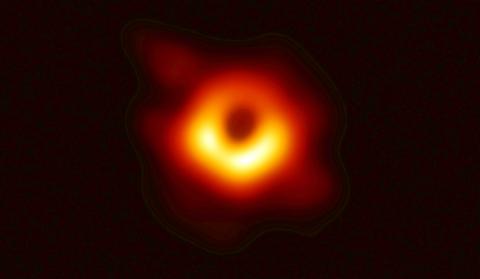Using a global network of telescopes to “see the unseeable,” an international scientific team on April 10 announced a milestone in astrophysics — the first-ever photo of a black hole — in an achievement that validated a pillar of science put forward by Albert Einstein more than a century ago.
Black holes are monstrous celestial entities exerting gravitational fields so vicious that no matter or light can escape. The somewhat fuzzy photo of the black hole at the center of Messier 87, or M87, a massive galaxy in the center of the relatively nearby Virgo galaxy cluster, shows a glowing ring of red, yellow and white surrounding a dark center.
The research was conducted by the Event Horizon Telescope (EHT) project, an international collaboration involving about 200 scientists begun in 2012 to try to directly observe a black hole’s immediate environment. The announcement was made in simultaneous news conferences in Washington, Brussels, Santiago, Shanghai, Taipei and Tokyo. The image was obtained using data collected in April 2017 from eight radio telescopes in six locations that essentially create a planet-sized observational dish.

Photo: REUTERS
照片:路透
The team’s observations strongly validated the theory of general relativity proposed in 1915 by Einstein, the famed theoretical physicist, to explain the laws of gravity and their relation to other natural forces. “We have achieved something presumed to be impossible just a generation ago,” said astrophysicist Sheperd Doeleman, director of the Event Horizon Telescope at the Center for Astrophysics (CfA), Harvard & Smithsonian.
Black holes, phenomenally dense and coming in various sizes, are extraordinarily difficult to observe by their very nature. A black hole’s event horizon is the point of no return beyond which anything — stars, planets, gas, dust and all forms of electromagnetic radiation — gets swallowed into oblivion. The M87 black hole observed by the scientific team resides about 54 million light-years from Earth and boasts an almost-unimaginable mass of 6.5 billion times that of the sun. A light year is the distance light travels in a year, 9.5 trillion km.
The existence of black holes was first predicted in 1916. Most galaxies are thought to have a supermassive black hole at their center. The fact that black holes do not allow light to escape makes viewing them difficult. The scientists looked for a ring of light — super-heated disrupted matter and radiation circling at tremendous speed at the edge of the event horizon — around a region of darkness representing the actual black hole. This is known as the black hole’s shadow or silhouette.
The scientists said Einstein’s theory correctly predicted that the shape of the shadow would be almost a perfect circle. With M87, it deviated from perfect circularity by less than 10 percent. Einstein’s theory also was validated by another major astrophysics achievement announced in 2016, the detection of gravitational waves, or ripples in spacetime, arising from two black holes that smashed together.
The project has also targeted another black hole — Sagittarius A* (pronounced “Sagittarius A-Star”) — situated at the center of our own Milky Way galaxy. Scientists expressed optimism about getting a picture of that one, perhaps within a year. Sagittarius A* possesses 4 million times the mass of our sun and is located 26,000 light-years from Earth.
Streaming away from M87 at nearly the speed of light is a humongous jet of subatomic particles, though that was not captured in the photo. The researchers estimated that the observed shadow of M87 is roughly 2.5 times larger than the actual size of the black hole’s boundary — the event horizon — due to light bending because of the extreme gravitational forces. They think the event horizon measures just under 40 billion km across, about three times the size of Pluto’s orbit around the sun.
The project’s researchers obtained the data using radio telescopes in the US states of Arizona and Hawaii as well as in Mexico, Chile, Spain and Antarctica. Since then, telescopes in France and Greenland have been added to the global network.
(Reuters)
為了一睹宇宙中的「不可見」,一組國際科學團隊運用多台望遠鏡組成全球網絡,並於四月十日宣布達成一項天體物理學的重大里程碑──人類史上首張黑洞照片。這項成就證實了艾伯特.愛因斯坦在超過一世紀之前提出的一項科學理論支柱。
黑洞是怪物級的天體,運作的重力場實在太過兇惡,以致於沒有任何物質或光線能夠逃離。這張略顯模糊不清的黑洞照片顯示出紅色、黃色和白色組成的閃耀光圈,圍繞著一個黑暗的中心。該黑洞位於梅西爾87星系(或稱M87星系)中央,而這個巨大的星系則位處相對接近的室女座星系團中心。
這份研究由「事件視界望遠鏡」計畫主導,是一項跨國合作、約二百位科學家參與的研究計畫,始於二○一二年,試圖直接觀察到最接近黑洞的週邊環境。研究成果正式發表於華盛頓、布魯塞爾、聖地牙哥、上海、台北與東京同步召開的記者會。科學家運用八座電波望遠鏡在二○一七年四月蒐集的資料,彙整出這張黑洞影像;這些望遠鏡建於全球六個不同地點,構成口徑大小相當於一整個行星直徑的巨大望遠鏡。
研究團隊的觀察結果強力證實了愛因斯坦於一九一五年提出的廣義相對論,這名聲譽顯赫的理論物理學家當年藉由這個理論解釋萬有引力定律和其他自然力的關係。哈佛史密森尼天體物理中心的「事件視界望遠鏡」計畫主任,同時也是天體物理學家的薛柏德‧多勒曼表示:「我們已經達成一項上個世代還認為不可能的成就。」
黑洞的密度驚人地高,大小各異,因其特殊的本質而極難觀測。在一個黑洞周圍,會有所謂的事件視界,也就是一個無法回頭的分界點,任何事物一旦越界──無論是恆星、行星、氣體、塵埃,以及所有形態的電磁輻射──都會遭到吞噬,從此湮沒無蹤。科學家團隊這次觀測的M87星系黑洞距離地球約五千四百萬光年遠,質量是太陽的六十五億倍,巨大程度幾乎無法想像。一光年是光線(在宇宙或真空中)在一年中旅行的距離,大約是九點五兆公里。
一九一六年,黑洞的存在第一次被預測出來。一般認為,絕大多數的星系中央都有一個超大質量黑洞。但是黑洞不讓光線逃脫,使得觀測它們相當困難。科學家遂轉而尋覓一個環狀光圈──來自於受到超高溫加熱的破碎物質和輻射,在事件視界的邊界以極快的速度繞圈所形成──圍繞著一塊漆黑區域,也就是實際上的黑洞。這就是所謂的黑洞陰影或黑洞剪影。
科學家指出,愛因斯坦的理論正確預測出黑洞陰影的形狀會是一個幾乎完美的圓圈。在M87黑洞的案例中,它跟完美的圓相差不到百分之十。愛因斯坦的理論也獲得另一項於二○一六年公布的重要天文物理學成就所證實,也就是重力波──或是時空中的漣漪──被偵測到確實存在,因兩個黑洞互相撞擊而產生。
這份計畫同時也將目標對準另一個黑洞──人馬座A*,該黑洞位於我們的銀河系中央。科學家對於獲得此黑洞照片的可能性表示樂觀,有望在一年內達成目標。人馬座A*這個黑洞的質量是太陽的四百萬倍,距離地球兩萬六千光年。
次原子粒子組成一股巨大噴射氣流,以接近光速的速度從M87黑洞向外湧出,不過並沒有被照片捕捉到。根據研究人員估算,這次觀察到的M87黑洞陰影大約是該黑洞邊界──事件視界──實際大小的二到二分之一倍大,原因在於極端的引力作用導致光線彎曲。科學家認為實際的事件視界直徑約略小於四百億公里,也就是冥王星繞行太陽軌道的三倍大。
該計畫研究人員先前獲得的資料來自美國亞利桑那州、夏威夷,以及墨西哥、智利、西班牙、南極洲等地的電波望遠鏡。之後,法國以及格陵蘭的電波望遠鏡也加入了這個全球網絡。
(台北時報章厚明譯)

Have you ever wondered why “Manila envelopes” carry that name? The answer lies in a plant native to the Philippines. Though a fruit-producing plant, abaca is most valued for its leaf stalks, which are __1__ to extract fibers known as “Manila hemp.” These fibers are known for their strength and resistance to saltwater. Because of its __2__ in sea environments, Manila hemp has long been used to make Manila rope, a staple in the sailing and maritime industries for centuries. It withstands harsh ocean conditions without its flexibility being __3__. Manila rope doesn’t break down easily when exposed to

A: In addition to boyband Energy’s concerts, Taiwan’s first major male dance revue has attracted attention. B: Several South Korean male dance revues and Australia’s Thunder from Down Under often tour Taiwan. Now Taiwan’s first all-male revue has finally appeared. A: According to the Liberty Times, Muscle High: A Male Dance Revue from Taiwan, featuring 13 hunks, opened last month and will run until Sept. 14. B: The rise of “hunk fever” in recent years has even caused a trend of working out in Asia. A: Let’s go to the Taipei Music Center’s Sub Livehouse for the show. A:

A: Any fun events happening this weekend? B: Boyband Energy’s concerts and Taiwan’s first major male dance revue have both sparked anticipation recently. A: Energy staged a comeback last year — 15 years after they disbanded — and they’re now more popular than ever. B: Their megahit “Friday Night” even won Song of the Year at the Golden Melody Awards. A: To pay tribute to the Queen of Pop Madonna, they added her choreography of 16 continuous jump squats to their music video, prompting a “16-squat challenge” that went viral across Taiwan. Do you wanna try it out? A:

In a major step to combat carbon emissions, Norway’s pioneering “Northern Lights project” is set to expand its carbon capture and storage (CCS) capabilities. Backed by energy giants and the Norwegian government, this collaborative project is working to increase its annual carbon storage capacity from 1.5 million to over five million tons. Northern Lights focuses on capturing CO2 emissions from industrial sources across Europe and securely storing them underground. Captured CO2 will be liquefied and transported by ship to the storage facility located off the coast of Norway. It will be injected through pipes into geological formations about 2,600m below the